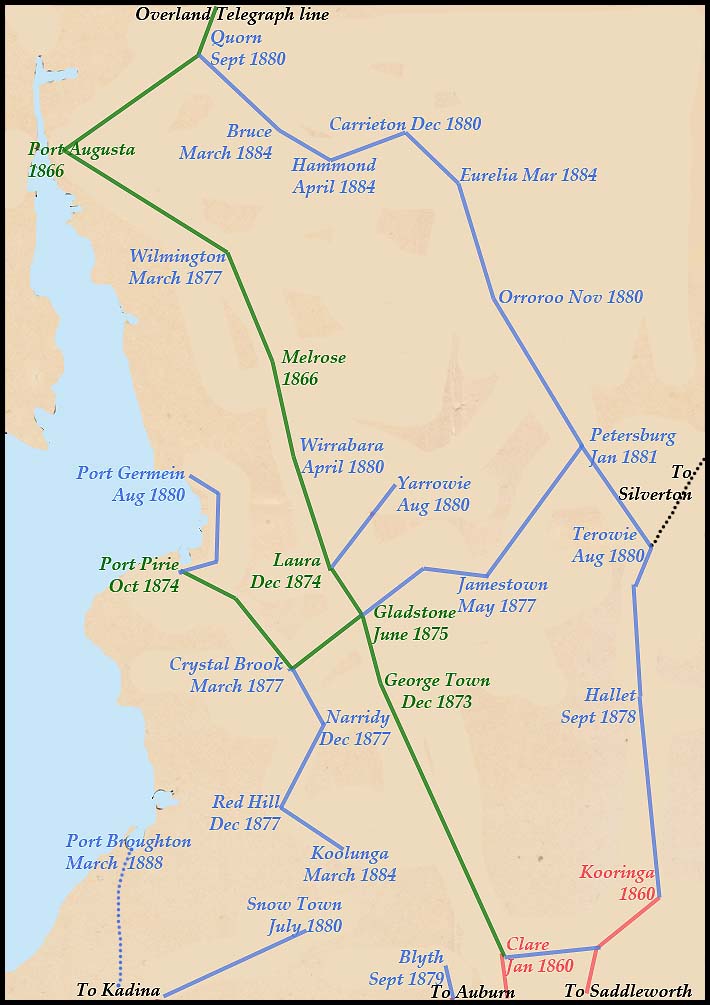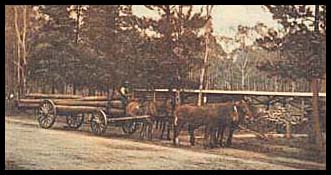Clare & Kooringa line to Port Augusta and Quorn.
- Site home & details
- Australia 1901-1988
- New South Wales
- Queensland
- South Australia
- Tasmania
- Victoria
- Western Australia
- International
- Special aspects
The upper northern line spans the region between Clare and Kooringa to Port Augusta and Quorn from where the Overland Telegraph line was constructed. Port Augusta is about 417 km from Adelaide and Clare is about 150 km from Adelaide - so the line in the upper northern region spans about 260 km.
This line was critical politically. In the mid-1860s, the battle between the South Australian and Queensland Colonial Governments over who should construct a telegraph line to link internationally through Java and India to England was becoming fierce. South Australia strengthened her position for that telegraph line in 1865 when Parliament authorised the construction of a telegraph line between Adelaide and Port Augusta - although agreement had been reached in the House of Assembly on 21 September 1862 to include funds enabling the construction of a telegraph line from Port Augusta to Mount Remarkable (Willmington). The 1865 decision built on the information acquired by John McDouall Stuart when he successfully crossed the continent to Chambers Bay in 1862.
 |
The main link to Port Augusta was constructed in 1866 - from Clare to Melrose (a distance of about 130 km) and then on to Port Augusta. The line to Melrose was opened on 28 August 1866 while the line to Port Augusta was opened on 31 August. A copper deposit had been found in Melrose in 1846 but it closed in 1851 only to re-open on two subsequent occasions. It was however one of the few townships in the Flinders ranges at that time.
The total cost of the line to Melrose and Port Augusta, including instruments and batteries, but exclusive of stations, was £8,479 4s. 7d. That total was considerably in excess of the estimate - mainly because of the high price of the poles. Swan River mahogany poles were used for the last 33 miles beyond Melrose. There was also an increased cost on all country works in 1865. The line from Clare to Port Augusta worked very well with few problems. The major problem was when the line was interrupted for four days. After the line was thoroughly inspected between Melrose and the Port, it was discovered that the Station Master at Port Augusta had accidently reversed his battery wires!! |
The link to Port Augusta greatly facilitated discussions and planning related to the Overland Telegraph line (OLT) over the next few years.
Although Port Augusta was a busy port, especially for shipment of wool, it was not officially proclaimed until 1875. Ironically, the Town Hall had also been built in 1866 - but the railway from Adelaide did not reach it until 1882. The telegraph line was therefore of critical importance for Port Augusta.
But Port Augusta was also critical for the construction of a telegraph line to Darwin. It afforded a point for the delivery of materials close to where the start of the line could be.
The haste with which the Clare to Port Augusta was constructed reflects the political imperative.
After the OLT had been completed towards the end of 1872, there was a pause in construction activity in this region. Telegraph offices were opened at George Town, at Laura and then at Gladstone with other offices opening later according to demand. Within two years, construction resumed with a new line branching from the northern line west to Port Pirie. That line itself branched after the Crystal Brook office was opened in 1877 south to Narridy (which was proclaimed as a township and granted local government in 1876 on the basis of the wheat growing in the area) and then later extended to Red Hill and then 13 km to Koolunga. |
 Telegraph poles being carted from the forest between Laura and Wirrabara |
Meanwhile the Government had been regularly petitioned for a line to Port Broughton. Some petitions requested the construction of a telegraph line to Port Broughton taking it from Kadina via Alford through in a thickly populated farming district. Other petitions, ranging back to at least 1882, requested the line to Port Broughton should go from Redhill via Mundoora. These petitions "pointed out that a telegraph line to Port Broughton is urgently required, the most convenient route being via Redhill". Both lines was finally completed in February 1888.
Another line which came into this region was that to Snowtown from Kadina. The Wallaroo Times announced on 29 March 1879 that the telegraph line was "all but completed ... The contractors, Messrs. Crocombe and Cook, on Thursday last, connected the wire with the Kadina office. At the Snowtown end, there were a few square posts to erect and these will be put up long before any building is ready to receive the wire, no provision having as yet been made by the Government. This will be a great boon when in operation to the settlers, who have but very secondary postal arrangements at present. It will also be advantageous to the wheat buyers and others who are connected with the new township, which at the present time presents a very busy appearance. Buildings are going up fast, and from their extent it is evident the promoters have perfect faith in the future prosperity of the place". The Telegraph Office at Snowtown opened on 7 July 1880 - a mere 14 months after the line had been finished!
Second line: In 1879-80, major construction activity opened a second line north from Kooringa. A short line had linked to Hallett in 1878 and then the line ran to Terowie to Orroroo and Carrieton to meet the Overland Telegraph line at Quorn.
That additional line reduced the traffic on the line from Adelaide via Clare and Gladstone - traffic which was significant in number of messages coming into South Australia from four of the other Colonies.
Intermediate offices were opened as demand justified the expense or communities were prepared to guarantee the profitability of the Offices.
Mr. Knucky was in Quorn in March 1880 and it was expected he would commence the construction of the line soon. The town had some buildings completed and it was staring to look substantial.
In May 1880, Minister King said he was surprised Quorn , as flourishing as it was, did not have a telegraph and he wished to start construction of a building and a line from Terowie as soon as possible. In July 1880, the Assembly was informed the line to Quorn would be finished in a few weeks.